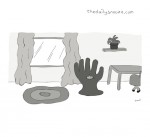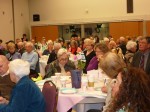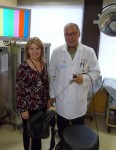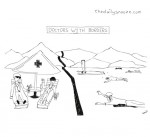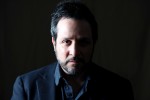For more cartoons, visit thedailysnooze.com.
Images
Retirement is something for which we must prepare, or “rewire”
It was a capacity crowd at Jewish Senior Alliance’s Spring Forum on May 4. (photo by Binny Goldman)
Gyda Chud, co-convener and current board member of the Jewish Seniors Alliance of Greater Vancouver, as well as an original member of the Peretz Centre for Secular Jewish Culture, enthusiastically welcomed a capacity crowd of 180 to this year’s annual JSA Spring Forum, which took place on May 4 at the Peretz. The theme was “Retired/Rewired.”
Chud acquainted those attending with the philosophy, programs and purpose of JSA and reminded us that life learning leads to the best quality of life. She advocated that we should all be volunteers, saying, “Volunteers are not paid – not because they are worthless but rather because they are priceless.”
Bev Cooper read her poem about how she came up with the word “rewired,” rather than retired. For Cooper, the word “rewirement” has become her cue to search for ways to ride the waves in the difficult times. And, in the more comfortable times, rewirement propels her to use the opportunity to seek out new challenges.
Cooper then called upon Gloria Levi, social worker, consultant in the field of gerontology and co-author of Dealing with Memory Changes as You Grow Older, to be the moderator of the afternoon’s forum. She spoke of her personal connection to JSA and introduced gerontologist Roz Kaplan, director of the seniors program at Simon Fraser University’s continuing studies.
Kaplan said that most people nowadays will live some 30 years after retirement and that we need to prepare for that time. Retirement is not a destiny but a journey for which we should “pack” essentials and, as with all journeys, some of us will be better equipped and prepared than others for the trip.
With the average life span for Canadians now into the 80s, we were encouraged to keep learning: an instrument, a language, dance steps, the means to rise to challenges and accept change.
We were told we needed confidants, connections, community and having a passion. This journey would be a path to opportunity and, as we age, we should divest ourselves of “extra luggage” to enable us to reinvent ourselves. Most of us got through life identifying ourselves with our work, noted Kaplan, and reinvention would allow us a chance to ease into retirement.
The stages of life usually encompass birth, education, work, retirement, death. It is up to us to fill in the gaps with personal growth. Many of us return to an encore career. Family, friends, fitness, travel, volunteering and various hobbies serve to keep us vital. A recommended read was Creating a Healthy Retirement by Dr. Ronald and Lois Richardson.
After a brief question period, Levi introduced speaker John F. Helliwell, an officer of the Order of Canada, a fellow of the Royal Society and senior fellow and co-director of the Canadian Institute for Advanced Research. As a professor emeritus at the University of British Columbia, Helliwell has written articles on “how to build happy lives,” the topic of his talk, and is a co-editor of The World Happiness Report.
We started by singing “If You’re Happy and You Know It.” Helliwell asked if we were any happier after the shared singing than before, and most, if not all, of us were.
How do we measure happiness? Usually this is not a question asked by our doctor or therapist; rather, we are asked if we are sad or depressed or possess negative feelings. Negativity is not only a state of mind but also affects our physical well-being, Helliwell explained.
An example was given of students in a hotel room who were all exposed to the rhinovirus. Those with negative feelings/attitude generally succumbed to the cold germ, whereas those with a positive outlook were much less affected, with some even escaping being sick entirely. It was also suggested that we need to concentrate more on health building rather than health repair.
Economic factors are far less important to happiness than bonds with other people and assisting each other to overcome strife and difficult circumstances. Iceland and Ireland were given as examples of quality of life because the people living there showed, on average, more concern and care for one another.
Aristotle stated that a fine quality of life brings happiness to individuals in a variety of forms but we all agreed on aspects needed for good quality of life: food, health, trust, freedom (to make decisions and feel actively engaged in one’s life) and generosity (doing nice things for others raises one’s own happiness).
Another example offered by Helliwell was of a care home in Denmark, where the staff had been asked to design the home as if they themselves were to be its residents. Their advice was to do away with uniforms for staff, to dispense with bibs and to make mealtimes variable. At one of the homes, the chef even drove the residents to a local movie theatre and they all enjoyed annual holidays together, more like one would expect if one were with close family.
In a residence where there were two floors, one known as generally happy, the other, unhappy, residents on the “unhappy floor” were asked to design the space in which they would be living in a new building and suggestions were made, followed and increased happiness ensued.
In another instance, a seniors residence was combined with a day care, and seniors and juniors interacted happily, all benefiting, a little like symbiosis. No one broke the rules, nobody wandered away searching for the home they had left – they all felt they were home.
During the question period, it was asked why Israelis are happy even though they live such stressful lives. The answer seemed to be that there really is no time for introspection. As well, all are united in the common bond to continue to defend and build their country and that aim/purpose builds happiness.
A last question was about how we can continue to be selfishly happy if many of the rest of the world seems so unhappy. The answer was, “Whose misery is lessened by our being unhappy?”
After summarizing the two speakers’ talks, Levi spoke of JSA president Serge Haber and his countless contributions to the community through the years and of his being one of those honored at the Louis Brier Jewish Aged Foundation’s Eight Over Eighty (on May 25).
Haber asked everyone to rise for a moment’s silence to mark Yom Hazikaron, commemorating fallen soldiers; he pointed out the Israeli flags in the centre of each flower arrangement, celebrating Israel’s Independence Day. As refreshments prepared by Bagel Club Catering were served by JSA volunteers, Haber thanked those who had convened the forum and emphasized that much of this would not have been possible without the efforts of the amazing staff, Karon Shear and Rita Propp. Shear also took a video of the forum, which will appear on the JSA website.
Herb Calderwood, the afternoon’s musical entertainer, handed out songbooks and charmed the crowd by announcing that he may not know all the songs in the book, as he does not read music, but he asked us to call out our request by number. He delighted us as well with a game of “Name That Tune,” and those who guessed the tune were rewarded with a prize. Door prizes further kept the happiness quotient high and the afternoon came to a happy conclusion, as the audience did indeed leave rewired.
Binny Goldman is a member of the Jewish Seniors Alliance of Greater Vancouver board.
Reenvisioning women at the Zack
The centrepieces of the show, two large paintings by Jazmin Sasky, are both based on Anita Diamant’s novel The Red Tent. (photo by Olga Livshin)
Across centuries, artists in different countries have depicted women in their multiple incarnations – among them, mother, muse, beloved, temptress. The new show at the Sidney and Gertrude Zack Gallery, called Envisioning Women, brings a new slant to the theme: how 21st-century Canadian artists see women.
The centrepieces of the show, two large paintings by Jazmin Sasky, are both based on Anita Diamant’s novel The Red Tent and, therefore, on the Torah. The women in the paintings could be just as easily from biblical or contemporary times, friends going on a camping trip or visiting a spa. The paintings’ festive red palette with its multiple nuances communicates the women’s contentment at being together, sharing the space. While the red tent in the novel refers to a place reserved for the females of the tribe, a place where they find mutual support and encouragement, in the paintings, the space alludes to a wider interpretation.
“I explored the sisterhood of women,” said Sasky. “It’s as relevant today as it was then, although in the biblical times, they all lived together. No secrets were possible, unlike us. We are much more private, but it was interesting to imagine those women, their lives.”
Her women don’t belong exclusively to the ancient tribe. They also live in the here and now, share our workspace and our holidays, walk along the same streets and into the same buildings. They are not afraid of change, of bursting out of the artificial confines of the “red tent” and into life.
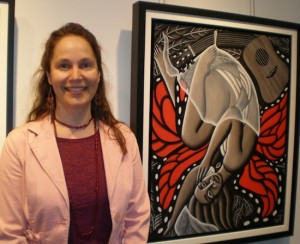
This courage and strength resonates in many other works in the show. The women in them assert their place in history and are willing to rebel, if necessary.
Nancy Henderson’s painting with the title “Sk8r grrl one” is one example of such a rebellion. It depicts a young female hockey player in a ridiculous costume of the beginning of the 20th century. The artist’s fiery words about her work read as a tribute to every Canadian woman: “I salute women of every generation who have defied everything from societal disapproval to outright bullying in order to get into every game, including the great frozen one.”
Carly Belzberg’s “Eve” doesn’t look like a traditional Eve of old either. This Eve participates; she gets into games. In her shorts and a tank top, sitting in a meditation pose, perhaps doing yoga, she is not afraid of the world unfolding around her, and her quiet courage transmits to everyone who comes into the gallery.
Life is changing, and we’re changing with it, coming out of our traditional cocoon of domesticity, where women were confined (by choice and not) for generations – that seems to be the message of the show.
Lori-Ann Latremouille’s painting “Emerging” embodies this idea. Her woman is transforming out of her restrictive silken shroud into wings and the world. She will fly and sing, and the guitar incorporated into the image signifies the connection between music and freedom. “Rebirth after dormancy,” commented the artist. Not surprisingly, she is a professional musician herself, and her painting is a story of metamorphosis. “It’s a new painting technique for me, too. I used to do drawings,” she said.
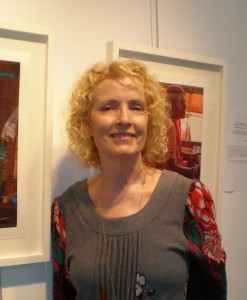
The line of timelessness, of connectivity, continues in Kathryn Gibson O’Regan’s serene photographs. “I travel a lot and always try to find what unites women of all times and cultures. Creativity is common: weaving and spinning and making textiles, from the Bible to our times. I visited villages in many countries in Asia.” Her photos of the weavers in India and Thailand emanate peacefulness, their deep colors soft and bright simultaneously.
In contrast, there is little that is peaceful in Linda Lewis’ display of pottery cups. Each one has a face painted on it, or rather a hint of a face, the eyes. They are called collectively “Hints.” About two dozen of the cups are arranged in two glass cases in the middle of the gallery, similar in shape and size, but varied in their facial expression. Some cups stand in groups, like friends gossiping. Others are alone, in pain or pleasure. Still others resemble family clans, with love and antipathy intermixed. The whimsical complexity of women’s lives in pottery is fresh and unexpected.
It’s impossible in a short article to tell about each of the 15 artists participating in the exhibit – all of them add their unique perspective to the image of “contemporary woman,” and readers are encouraged to visit the gallery. Unfortunately, they won’t be able to experience one aspect of the show – the JCC Shalom Dancers. As the exhibit is in collaboration with Festival Ha’Rikud, its opening night featured a group of young dancers, led by Marla Simcoff and Jessica Bradbury, who presented a short but beautiful routine, a teaser of their full-length performance. Six young women in long black dresses, trimmed with red and yellow, with large red fans, danced in the atrium of the community centre, bringing dramatic energy and gladness to gallery patrons. They were the real-life embodiment of the paintings, women of the 21st century.
Envisioning Women will be on display until May 25.
Olga Livshin is a Vancouver freelance writer. She can be reached at olgagodim@gmail.com.
Critics peek under the Conference umbrella
President Barack Obama meets with leaders of the Conference of Presidents of Major American Jewish Organizations in the state dining room at the White House on March 1, 2011. (Official White House photo by Pete Souza)
Since the Conference of Presidents of Major American Jewish Organizations voted April 30 to reject the membership application of the self-labeled “pro-Israel, pro-peace” lobby J Street, the umbrella group has come under siege with accusations of not being adequately representative of U.S. Jewry’s views and for being controlled by a faction of right-wing members.
Yet a closer look at the Conference’s makeup reveals the prevalence of politically centrist or apolitical organizations – particularly among its largest members – such as Jewish National Fund, Hadassah, Anti-Defamation League, American Jewish Committee, B’nai B’rith International, Jewish Federations of North America and American Jewish Joint Distribution Committee. Also included in the Conference are openly liberal groups such as Ameinu and Americans for Peace Now.
“A majority of the groups voting against J Street were secular, centrist groups, not religious or right-wing,” Zionist Organization of America national president Morton A. Klein suggested, noting that by his count there are no more than 11 religious or right-wing groups among the Conference’s 50 members.
“To say it’s not inclusive when you have Peace Now, Ameinu, [American Friends of] Likud and ZOA in the Conference, is an absurd statement,” Klein added.
J Street responded to the vote with a letter on its website addressed to Conference of Presidents executive vice-chairman/chief executive officer Malcolm Hoenlein, stating, “Dear Malcolm: Thank you for finally making it clear that the Conference of Presidents is not representative of the voice of the Jewish community. We recognize the need for an open and honest conversation on Israel in the United States. We appreciate you being honest. Now we’ll work on the openness.”
To gain membership in the Conference, J Street needed the support of two-thirds of the body’s members. Forty-two members showed up for the vote, whose final tally was 22 against J Street, 17 in favor and three abstentions.
Inclusive and accessible playgrounds
Equipment like the Roller Table can help children develop their upper body muscles. (photo by Deborah Rubin Fields)
Not all playground equipment is created equal. Some equipment is accessible while some is not. Certain equipment is accessible to young wheelchair users, yet cannot be labeled inclusive play apparatus. However, some playground items are both accessible and inclusive and, notably, provide wheelchair-bound children with opportunities for either muscle toning and/or creative play.
Landscape Structures has designed a number of accessible and inclusive pieces of playground equipment. Take, for example, the new ZipKrooz. This is a scaled-down version of the popular adult zip line. The young passenger sits in a hard, high-back seat, secured with a harness. For safety, the chair runs fairly close to the ground. Gravity propels the child across the line. Close to the end of the line, the chair rocks back toward the centre before coming to a stop. The launching action is repeated, as many times as desired. A child using a wheelchair might need help from a grown escort to assist with the transfer to and from the wheelchair to the zip seat, to position the child at the beginning of the line, and to gently push the back of the chair to launch the occupant.
The Play Booster Sway Fun Glider is a roomy, communal “landed” boat that artificially creates wave motion. The “sailors” can either rock the boat from their seated positions or assistants can stand outside the bow or stern, swaying the boat. Wheelchair access is provided via a pull-down ramp. Sitting around a bolted-down table, two wheelchair-using youngsters may join in imagery play with other passengers. Wheelchairs are apparently not locked down; instead, wheelchair users either stabilize themselves with their chair’s brakes and with the table’s hand holds or have their attendants sit behind them, holding the chair’s back hand grips.
The next three play lot items not only promote inclusion and accessibility, but also muscle strengthening. The Accessible Stationary Cycler, the Accessible Power Lifter chinning bar and the Roller Table, for example, help children develop the muscles in their upper body – in their arms, upper back, neck and/or chest. Each apparatus is built low enough so that children using wheelchair mobility (and who have use of their arms and hands) can either reach up to raise themselves out of their chairs or sit in their chairs to comfortably play.
The following two pieces of equipment provide for inclusion and accessibility while focusing on creative enterprise.
Landscape Structures manufactures what it calls an Elevated Sand Table. This raised sandbox allows juvenile wheelchair users (who have use of their arms and hands) to build sandcastles from their chairs. From a standing position, children without physical disabilities play alongside.
The Chimes Reach Panel lets wheelchair users and non-physically challenged children to literally play harmoniously. They may make music together by ringing a row of chimes.
On the other side of the accessibility spectrum (and geographically on the other side of the world), there is the Australian-made Liberty Swing. With its design to accommodate most wheelchairs, this swing is apparently a big hit in Australia, yet this equipment sometimes stands off to the side of the other playground equipment, fenced off and under lock and key.
Admittedly, vandalism and theft are problems playground officials face worldwide. But this reality means that while the swing is accessible to children who use wheelchair mobility, it is not necessarily mainstream integrated.
Play is necessary for a child’s physical and mental development. In the Western world, playing with one’s peers, regardless of one’s physical or mental ability, has been deemed a child’s right. Overall, the surveyed play items show significant progress has been made in fulfilling this objective. Physical and occupational therapists who work with children would do well to encourage their young clients and their families to make use of such equipment, and to try and make playgrounds everywhere as accessible and inclusive as possible.
Deborah Rubin Fields is an Israel-based features writer. She is also the author of Take a Peek Inside: A Child’s Guide to Radiology Exams, published in English, Hebrew and Arabic (take-a-peek-inside.com).
Hold a newborn like a kangaroo
Premature babies experience long-term benefits from skin-to-skin contact with their mothers for a short time every day. (photo from israel21c.org)
A new Israeli study reveals that “kangaroo care” for premature babies has life-long effects on neurological and psychological development. Conducted by Dr. Ruth Feldman – a professor in the department of psychology and in the Brain Research Centre at Bar-Ilan University and adjunct professor at the Child Study Centre at Yale – the study shows that skin-to-skin contact between mother and newborn improves brain functioning later in life.
The concept of “kangaroo care” (named for the way that this marsupial carries her unformed offspring in her pouch) is not new. Introduced by neonatologist Edgar Rey Sanabria in 1978 in Bogota, Colombia – where access to incubators was limited – it is a method of using maternal body heat to prevent hypothermia in preemies. That it proved effective in keeping infants warm made sense, but Feldman and her research team set out to examine whether it had a measurable influence.
They began performing a double-blind longitudinal study in 1996 and 1998, looking at one group of 73 premature babies in a neonatal unit receiving standard incubator care, and another set of 73 whose mothers provided skin-to-skin contact for one hour a day for two weeks in a row. The parents in the control group were not aware of the kangaroo-care study, but were offered ongoing psychological and medical care for their babies.
At seven intervals over the course of the next decade, all 146 of these children were tested with brain scans. Today, they are 16 to 18 years old.
“What we found was that the children in the kangaroo-care group had better cognitive skills, sleep patterns and a higher functioning autonomic nervous system, better able to cope with stress,” Feldman said. “And their mothers were more sensitive parents.”
Winnipeg’s HAlt program offers alternatives to a hysterectomy
Shauna Leeson and Dr. Richard Boroditsky. (photo by Rebeca Kuropatwa)
According to Dr. Richard Boroditsky, medical director of Winnipeg’s Mature Women’s Centre, hysterectomies are procedures that happen too frequently and are often unnecessary. Boroditsky has spearheaded a new program to give women effective alternatives to hysterectomies.
The program, called HAlt (Hysterectomies Alternatives), is managed by Kerry Antonio, and previously by Shauna Leeson, both nurse clinicians who have been working at Mature Women’s Centre since 2004. In 2006, the centre moved to Victoria Hospital.
There are currently three physicians working with HAlt – Boroditsky, his son Dr. Michael Boroditsky and Dr. Deb Evaniuk.
Patients are often referred by their family physician. The majority are in the age range of 30-55, with heavy or painful periods, and all want to improve their quality of life. Women in the post-menopausal stage are also seen at HAlt. “The majority of the patients we see here have benign ‘disease,’” Leeson told the Jewish Independent.
“Too many women are being told they have only two choices: do nothing or get their uterus taken out. We see about 20 new patients per month. We’re here to give them other options to hysterectomy and we do this because we understand the consequences of having one.”
Leeson added, “If a women in her 40s or 50s is going to have a hysterectomy, she may need to take six to eight weeks or up to three or four months off work and her regular duties, where often her problem can be treated with medication or other alternatives.”
According to Boroditsky, “Manitoba probably has one of the highest hysterectomy rates in Canada, with some 2,300 hysterectomies per year in the province.
“Traditionally, the main reason for doing about 70 percent of hysterectomies has been abnormal bleeding. And, before we had some of the newer alternative hysterectomy technologies, there wasn’t much we could offer women.”
The doctor said one of the most common issues they see is a condition called uterine fibroid (benign lumps in the uterus). “We used to believe this meant women in this situation automatically needed a hysterectomy,” he explained.
“Hysterectomy is a major operation with major complications – including risks of general or spinal anesthesia, hemorrhaging, infection and damage of organs around the uterus,” like the bowel, bladder, ureter, etc. “With these serious, major complications that can occur, we shouldn’t be taking hysterectomies lightly,” he said. “We can’t look at hysterectomy as the ultimate treatment for uterine bleeding – it shouldn’t be the first choice. It should only enter into the picture after you’ve tried or considered all other available alternatives.”
In the past, Boroditsky said that he has done at least as many, if not more, hysterectomies than other physicians, but that has changed in recent years. “I’ve gone the other way. I now believe hysterectomies should be only a last resort.”
He added, “One particular study was done about eight or nine years ago in the States, where they looked at several thousand hysterectomies and found that some 70 percent of them could have been treated or managed with other alternatives.”
In Europe, alternatives to hysterectomies are more accepted due to the attitudes of both the doctors and the patients, said Boroditsky. “In Canada, many women, and even doctors, don’t know about or will not consider alternative options.
“There is a lot more cost involved in having a hysterectomy than there is for the alternatives: cost to the system, physical and psychological cost to the woman and to her family. The only way we can make an accurate diagnosis of abnormal uterine bleeding is to look inside the uterus (hysteroscopy). Once you make the diagnosis, there are many alternatives for treatment, depending on each individual case, whether that’s with pills, a device or otherwise.”
The HAlt website offers basic information and some of the benefits of the alternatives to hysterectomy. “Due to the risks associated with major surgery, as well as the negative effects hysterectomy can have on a woman’s self-esteem, their sexual experience and perceived desirability, women are seeking alternative treatments to fibroids and uterine bleeding. The HAlt program aims to provide women with information and awareness of options, including the use of medical alternatives to control bleeding, minimally invasive surgery, and other less invasive techniques.”
Some of the medical alternatives available today include the use of an intrauterine progestin device, which prevents pregnancy but significantly reduces menstrual flow; pituitary gonadotropin inhibitors, which lock estrogen receptors in the uterus to suppress hormone levels and thin the lining of the uterus; oral contraceptives to minimize and regulate menstrual bleeding; gonadotropin-releasing hormone, which produces a menopause-like state, indirectly lowering estrogen levels and shrinking fibroids; and selective progesterone receptor modulators, which act directly on the fibroids and the lining of the uterus, leading to fibroid shrinkage and decreased bleeding.
As noted on the website, patients can consider adding procedures in consultation with their doctors, such as endometrial ablation, hysteroscopic resection of polyps and fibroids, as well as uterine fibroid embolization.
Rebeca Kuropatwa is a Winnipeg freelance writer.
Winnipeg’s Mall Medical was established by Jewish doctors
The Mall Medical Clinic building is now owned by the Winnipeg Art Gallery. (photo from wag100.ca)
The Mall Medical Clinic goes as far back as the final days of the Second World War, when two Manitoba doctors at an overseas army hospital (one ill and recovering, while the other was treating him) discussed what they would do after the war. They decided to create a joint medical practice for returning physicians.
The original group of doctors involved with establishing Winnipeg’s Mall Medical included Alan Klass, Charles Bermack, Laurie Rabson, Sam Easton, David Bruser, Ruvin Lyons, Manly Finklestein and Norman Book. Early in 1947, the Mall Medical Group purchased a piece of land at the northwest corner of The Mall (at 280 Memorial Blvd.) and hired architects Green Blankstein Russell to design their clinic. Construction started on the two-storey building with a full basement on March 4, 1947. The facility was open by January 1948.
Aside from doctor and dentist offices, the building housed a pharmacy, lab and diagnostic equipment rooms. By 1990, the Mall Medical Group also ran additional clinics at 1194 Jefferson Ave., 1717 Main St., and 1868 Portage Ave.
Dr. Norman Goldberg, 64, a pediatrician who was born and raised in Winnipeg, began working at the clinic in 1976.
“I looked around and saw that Mall Medical was a well-established group and was willing to take in a new colleague,” he said. “Not every group was able or willing to do this. I knew some of the Mall Medical doctors and there was a strong Jewish representation of doctors. They were accepting of Jewish physicians, whereas some were less welcoming.
“The Mall Medical Group all started when a group of Jewish doctors decided to start up a combination of family practice and specialists – to have a little more marketing power and to be able to help each other out,” to refer within the group to each other.
“There was certainly a Jewish influence there, and it was to counter some of the exclusionary practices at some of the other clinics.
“Over the years,” he added, “people joined us from various specialties, as well as general medicine. It [retained] less of a Jewish identity over time, because there were no longer exclusionary policies.” Even later, however, “there were still very few Jewish physicians at the Winnipeg or Manitoba Clinic. That has since improved.”
The Mall Medical Group dissolved around 1996. “We were finding it harder to recruit physicians,” Goldberg explained. “We were no longer able to compete in the market space as it was, in the space we were in. It was becoming too expensive to maintain the building and there were other reasons, too.
“We were all doing well and were busy, but we needed another eight or 10 physicians to make it really function well and we couldn’t recruit that number.”
At that point, Goldberg moved to the Manitoba Clinic. By then, he said, things had changed for Jewish physicians. At the Manitoba Clinic, for example, “They were very welcoming. I was pleased to be there and they were pleased to have me. I never felt any exclusion from the rest of the group. We all got along very well.”
Still, Goldberg remarked, “Today, you’re expected to forget past history, which isn’t always that comfortable. I think you still need to be a little aware of what past history was, although right now things are good.”
One of the other doctors in the Mall Medical clinic was Dr. Nassif Moharib. He was born in Egypt, where he became a doctor, and moved to Canada in 1967. “I’m a Christian and was hated because of that by extremist Muslims in Egypt,” said Moharib of his decision to move overseas.
After arriving in Winnipeg in 1967, the doctor did emergency work at Misericordia Hospital for six months, and then did over a year of training/residency in neurology.
“My wife was working as an operating room nurse at Children’s Hospital, when one of the doctors from Mall Medical was saying that the neurologist at Mall Medical was leaving the group, so they were looking for a new neurologist,” he recalled.
He went for an interview at the Mall and was accepted in 1970. “When I joined, there were only about three non-Jewish doctors of about 26 or 29 doctors there,” Moharib said. “The majority of doctors in the Mall Medical Group would refer their patients to me. We were all very friendly with each other. Dr. Phil Barnes delivered two of my children. It was a very good, friendly atmosphere.”
Today, Moharib is retired and is unimpressed with current wait times to see a doctor. “I think it’s gotten a lot worse – longer – than it used to be. When I was working, I didn’t let patients wait for more than five minutes but, in some doctor’s offices, people have to wait for two hours. It’s not right. I think it’s because doctors are booking too many patients.”
In 1992, the Mall Medical group vacated its original location on Memorial Boulevard. The following year, the Winnipeg Art Gallery purchased the lot and a $750,000 infrastructure grant helped convert it into the WAG Studio.
Rebeca Kuropatwa is a Winnipeg freelance writer.
This week’s cartoon … May 16/14
For more cartoons, visit thedailysnooze.com.
Ben Ratner takes risks on and off stage
Ben Ratner (photo from Kindred Entertainment)
Ben Ratner is a man of many talents with an impressive resumé – boxer, musician, artist, stand-up comedian, actor, writer, producer and director – a Jewish Renaissance man, but more importantly, he’s down-to-earth mensch. On a rainy Saturday afternoon, Ratner sat down with the Independent in his shabby chic east side Haven Studio to talk about his current film and theatre projects.
Hot off his success with his award-winning film Down River, which he wrote, produced and directed, he is presently at the helm of the Canadian première of Tommy Smith’s White Hot, which opened May 8 and runs until May 17 at the Shop Theatre at 125 East 2nd Ave.
Down River is a tribute to his late friend and mentor Babz Chula, a local actor who succumbed to cancer in 2010 at the age of 64. “Babz was ageless, she could bridge the gap between a kid in a sandbox and a wise old lady wrapped up in her shawl. She was this petite little thing, but so full of life and energy. In 2003, she played my mother in the first feature film I wrote and directed, Moving Malcolm. We were very close,” said Ratner.
The film is a poignant mix of humor and drama and locally shot. It tells the story of four women, who all live in the same West End apartment building, three 20-/30-somethings (Gabrielle Miller, Colleen Rennison and Jennifer Spence, Ratner’s real-life wife) and a middle-aged divorcée (Helen Shaver), each struggling with a personal crisis; the younger ones searching for their identities and life purpose and Pearl, the older character, providing guidance in the midst of battling with pancreatic cancer. The film has been described as “eschewing cliché in a thoughtful, well-acted look at several generations of women at a crossroads in their lives.”
As to the Jewish aspect of the film, Ratner pointed out, “We never actually say that Pearl is Jewish in the film, but the hints are there, the menorah in the window in her apartment and the memorial service, which we shot inside the Or Shalom Synagogue.”
Chula’s presence is felt more than just as inspiration for the subject matter of the film. Pearl wears some of Chula’s clothes in various scenes, items from her apartment are used as props, the three young women each wear one of her signature bracelets, and Spence wears her “Coke-bottle glasses.” The letter read at Pearl’s memorial service is an abridged version of what Ratner shared with attendees at Chula’s celebration of life. Ratner’s own large-scale abstract canvases are used as the art gallery props. The addition of these personal touches makes the film intimate and engaging.
Down River has garnered more accolades than Ratner imagined it would. “We had 99-percent positive reviews and a warm response from audiences, and I saw how my film could affect people. They come out of the theatre smiling but blowing their noses. This story is not about dying, it is about living without fear.” Audiences voted Down River Most Popular Canadian Film at the 2013 Vancouver International Film Festival and critics named it the Best B.C. Film of 2013. It has been nominated for 13 Leos and is presently making the rounds of the North American film festival circuit.
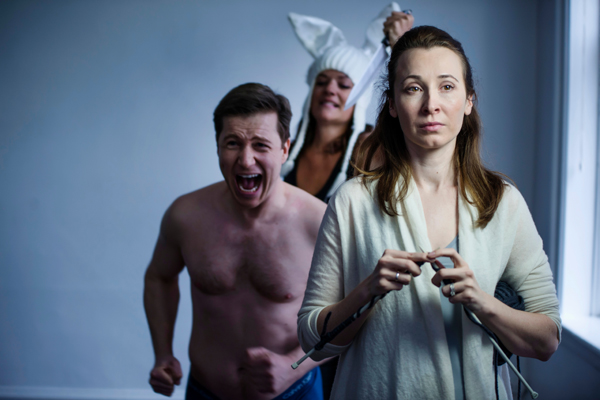
While Ratner is basking in the glow of the success of his cinematic opus, he is focusing his directing talents on the intimate world of black-box theatre with White Hot. The press release describes it as “a darkly comedic psycho-drama crammed into a love triangle between a troubled woman, her opportunistic husband and her trashed sister.” Ratner explained, “I am doing this play with my colleague, Loretta Walsh, who teaches with me in my acting studio. Her character is a great part for her terrific acting skills and brings the message that one should remain hopeful and strong and dignified no matter how brutal the circumstances. It is a dark play, unapologetically harsh, violent and sexually explicit. It is a risk for us to do the play. Not everyone is going to like it. But that is not going to stop us from going there.”
Ratner quoted playwright John Patrick Shandley (Doubt) in making his point: “Theatre is a safe place to do unsafe things that need to be done.” He continued, “ We could have done a crowd pleaser, but that is not what we are all about; this play will offend. However, I do not do theatre in order to aim for the middle. I need to do something to wake up this town and challenge the actors on a level that is not just about playing a part but finding some real humanity to it. There is no resolution at the end of this play, no answer, just an acceptance by the characters of the way things are.”
Not content with only personal success, Ratner is teaching future generations of actors in his studio. “Being a teacher is the most satisfying thing I have ever done. It enables me to have a purpose beyond my own gain. It allows me to give and not just take.”
And, there are plans for the future. “Long term, I will be teaching for the rest of my life. Short term, I want to make another film and reach bigger audiences. Down River was all about women. I am now working on another film that will be about men working through their mid-life crises.” In response to whether that topic is autobiographical (Ratner is 49), he laughed, “There’s always a bit of you in everything you write.”
For information and tickets to White Hot, visit kindredentertainment.com.
Tova Kornfeld is a Vancouver freelance writer and lawyer.

